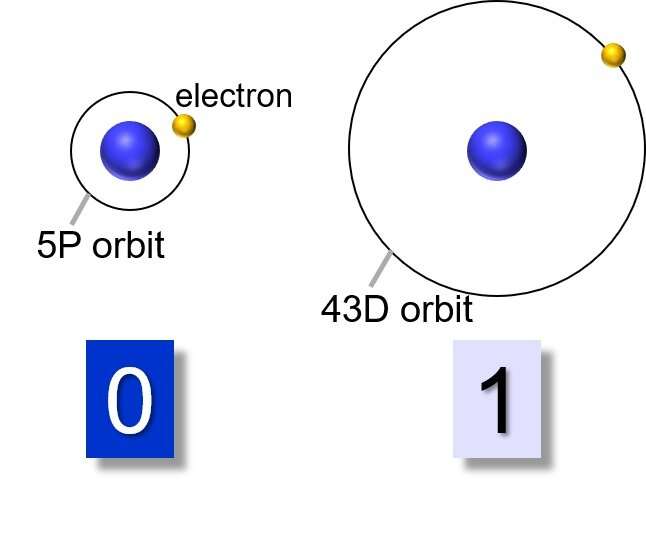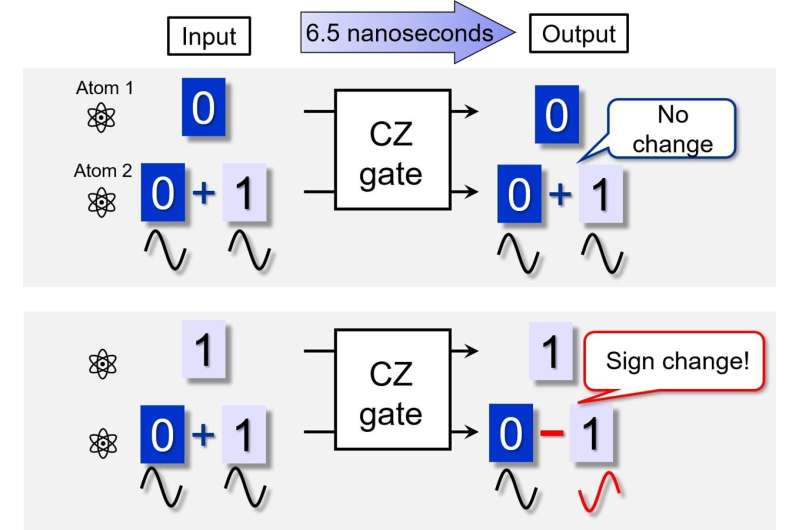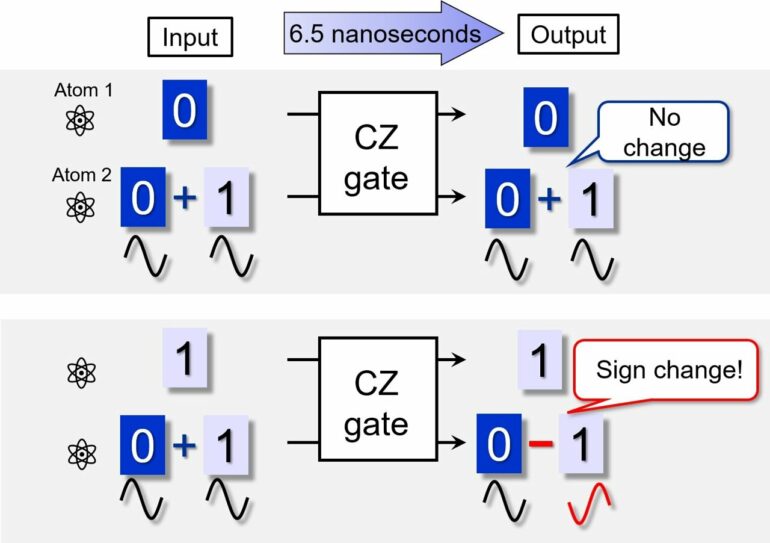A research group led by graduate student Yeelai Chew, Assistant Professor Sylvain de Léséleuc and Professor Kenji Ohmori at the Institute for Molecular Science, National Institutes of Natural Sciences, is using atoms cooled to almost absolute zero and trapped in optical tweezers separated by a micron or so (see Fig. 1). By manipulating the atoms with a special laser light for 10 picoseconds, they succeeded in executing the world’s fastest two-qubit gate, a fundamental operation essential for quantum computing, which operates in just 6.5 nanoseconds.
This ultrafast quantum computer, which uses ultrafast lasers to manipulate cold atoms trapped with optical tweezers, is expected to be a completely new quantum computer that breaks through the limitations of the superconducting and trapped-ion types currently in development.
The results are published in the online edition of Nature Photonics on August 8, 2022.
Cold-atom based quantum computers
Cold-atom quantum computers are based on laser cooling and trapping techniques celebrated by the Nobel Prizes of 1997 (S. Chu, C. Cohen-Tannoudji and W.D. Philipps, “Cooling and trapping atoms with laser light”) and 2018 (A. Ashkin, invention of the optical tweezers). These techniques facilitate the arrangement of arrays of cold atoms into arbitrary shapes with optical tweezers and allow each to be observed individually.
Because atoms are natural quantum systems, they can easily store quantum bits of information, the basic building block (“qubit”) of a quantum computer (see Fig. 2). In addition, these atoms are very well-isolated from the surrounding environment and are independent of one another. The coherence time (the time during which quantum superposition persists) of a qubit can reach several seconds. A two-qubit gate (an essential basic arithmetic element for quantum computing) is then performed by exciting one electron of the atom into a giant electronic orbital, called a Rydberg orbital.

Fig. 2. Schematic of a quantum bit using Rubidium atoms. © Dr. Takafumi Tomita (IMS)
With these techniques, the cold-atom platform has emerged as one of the most promising candidates for quantum computer hardware, attracting attention from industry, academia and governments around the world. In particular, it has revolutionary potential in that it can be easily scaled up while maintaining high coherence compared to the superconducting and trapped-ion types that are currently being developed.
Quantum gates
Quantum gates are the basic arithmetic elements that make up quantum computing. They correspond to the logic gates such as AND and OR in conventional classical computers. There are one-qubit gates that manipulate the state of a single qubit and two-qubit gates that generate quantum entanglement between two qubits. The two-qubit gate is the source of the high-speed performance in quantum computers and is technically challenging. The most important two-qubit gate is called a “controlled-Z gate (CZ gate),” which is an operation that flips the quantum superposition of a first qubit from 0 + 1 to 0—1 depending on the state (0 or 1) of a second qubit (see Fig. 3).

Fig. 3. Operation of the quantum gate. (Upper) When atom 1 is in the “0” state, nothing happens. When atom 1 is in the “1” state, the sign of the superposition of atom 2 is changed from positive to negative. This operation is at the heart of quantum algorithm that runs on quantum computers. © Dr. Takafumi Tomita (IMS)
The accuracy (fidelity) of the quantum gate is easily degraded by noise from the external environment and the operating laser, which makes the development of quantum computers difficult. Since the time scale of noise is generally slower than one microsecond, if a quantum gate that is sufficiently faster than this can be realized, it will be possible to avoid the degradation of calculation accuracy due to noise and bring us much closer to realizing a practical quantum computer. Therefore, for the past 20 years, all quantum computer hardware research has been pursuing faster gates. The ultrafast gate of 6.5 nanoseconds achieved by this research with the cold-atom hardware is more than two orders of magnitude faster than noise and thus can ignore its effects. The previous world record was 15 nanoseconds, achieved by Google AI in 2020 with superconducting circuits.
Experimental method
The experiment was conducted using rubidium atoms. First, two rubidium atoms in the gas phase that had been cooled to an ultra-low temperature of about 1/100,000 of a Kelvin using laser beams were arranged at a micron interval with optical tweezers. Researchers then irradiated them with ultrashort laser pulses that emitted light for only 1/100 billionth of a second, and observed the changes that occurred. Two electrons trapped respectively in the smallest orbitals (5S) of two adjacent atoms (atom 1 and atom 2) were knocked into giant electronic orbitals (Rydberg orbitals, here 43D). The interaction between these giant atoms then led to a periodic, back-and-forth exchange of the orbital shape and electron energy occurring with a period of 6.5 nanoseconds.
After one oscillation, the laws of quantum physics dictate that the sign of the wavefunction is flipped, thus realizing the two-qubit gate (controlled-Z gate). Using this phenomenon, they performed a quantum gate operation using a qubit (Fig. 2) in which the 5P electronic state is the “0” state and the 43D electronic state is the “1” state. Atoms 1 and 2 were prepared as qubits 1 and 2, respectively, and the energy exchange was induced using an ultrashort laser pulse. During one energy-exchange cycle, the sign of the superposition state of qubit 2 was reversed only when qubit 1 was in the “1” state (Fig. 3). This sign flip was experimentally observed by the research group, thus demonstrating that a two-qubit gate can be operated in 6.5 nanoseconds, the fastest in the world.
The realization of the world’s fastest ultrafast gate, achieved this time by a completely new method of “manipulating two micron-spaced atoms cooled to almost absolute zero using an ultrafast laser,” is expected to greatly accelerate worldwide attention to cold-atom hardware.
More information:
Sylvain Léséleuc, Ultrafast energy exchange between two single Rydberg atoms on a nanosecond timescale, Nature Photonics (2022). DOI: 10.1038/s41566-022-01047-2. www.nature.com/articles/s41566-022-01047-2
Provided by
National Institutes of Natural Sciences
Citation:
Researchers develop the world’s fastest two-qubit gate between two single atoms (2022, August 8)
